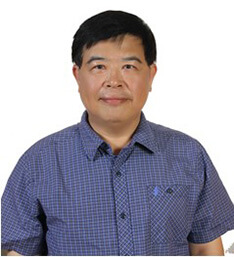Prof. Hsiang-Chen Hsu
I-Shou University, Taiwan
40th International Electronics Manufacturing Technology (IEMT) Conference 2024

Prof. Hsiang-Chen Hsu
I-Shou University, Taiwan
Invited Papers – Characteristics and optimization fingerprint recognition on different materials using deep learning algorithm
Abstract: Fingerprint recognition is one of the most well-known digital identifications and has been widely used on forensic science, criminal investigation, financial services, electronic smart locks …etc. In this paper, latent fingerprint marks have been image segmentation and reconstruction based on the Unet method. In the first, latent fingerprint marks were collected on Ninhydrin reaction thermal-induced paper and the image of fingerprints were segmented using Unet algorithm. Secondly, mutilated fingerprints were image reconstructed for the whole loops and whorls on a finger. And lastly, a Receiver Operating Characteristic (ROC) curves scheme has been applied to analyzed classification accuracy of a statistical developed model.

Prof. Sung Yi
Portland State University, USA
Invited Papers – Machine Learning Framework for Predicting Reliability of Solder Joints
Abstract: Solder Joint Reliability (SJR) is the probability that solder joints will provide proper electrical and mechanical connections over a specific period of time (design life) under the design operating conditions without failures. Reliability and lifetime predictions of solder joints in electronic packages have been one of the most difficult problems in the electronics industry. In general, in order to evaluate the reliability of solder joints, accelerated temperature cycle tests are conducted. The experimental determination of the fatigue life of the solder joints in electronic packages is a very time consuming process. After conducting accelerated temperature cycle tests, the failure data are further analyzed by the Weibull analysis to determine the Weibull parameters and the mean life. However, many previous studies show that the Weibull analysis may significantly underestimate or overestimate the reliability and the mean life to failure. The underestimation of the times to solder joint failures may result in fatal failures. For example, on 28 December 2014, Indonesia Air Asia Flight 8501, an Airbus A320-216, crashed into the Java Sea during bad weather, killing all 155 passengers and seven crew on board. On 1 December 1 2015, Indonesia’s National Transportation Safety Committee stated that the cracking of a solder joint of both channel A and B resulted in loss of electrical continuity and two flight augmentation computer (FAC) fault, which caused the autopilot and auto-thrust disengaged and contributed to the subsequent loss of control and a malfunction in two of the plane’s rudder travel limiter units. On the other hand, the overestimation of the times to failure may lead to consequently underestimating the maintenance interval, which may unnecessarily increase the maintenance cost.
The goal of this study is to propose a general machine learning framework to predict the reliability of solder joints accurately for electronic devices and systems. In this study, it will be demonstrated how to achieve this goal using the machine learning method.

Rav Bilkhu
ON Semiconductor, Canada
Invited Papers – 2.5-3D Heterogeneous Packaging
Abstract: The market need for more complex SIP (System In Package) modules continues to evolve with an ever growing demand for incorporating more functionality using more advanced silicon technology nodes within a single package. More recently, integration of low power Bluetooth wireless capability with high speed DSP (Digital Signal Processing) circuitry into a system solution, has challenged designers. Moreover, often these are conflicting needs demand novel packaging techniques in miniaturized ‘hybrid’ assemblies into a single and cost effective package. This has led to significant advances in developing manufacturable 2.5-3D Heterogeneous packaging technology. Unfortunately, many of the solution providers have a high barrier to entry due to low to mid-tier volumes in niche markets along with significant upfront tooling costs, which often are unable to justify a sustainable business case.
This presentation will discuss how, with pushing the limits and innovative use of established manufacturing processes, materials and off-the-shelf components, advanced miniaturized 2.5D-3D packaging solutions, have been successfully developed, into manufacturing. While continually pushing the envelope, much success has been achieved in delivering cost effective, high reliability SIP modules that are used in a variety of diverse applications such as audiology, wildlife tracking and CGM (Continuous Glucose Monitoring) solutions in medical applications.

Brian McGarvey
ON Semiconductor, Republic of Ireland
Invited Papers – Silicon Photomultipliers for LiDAR Applications
Abstract: LiDAR techniques are now being employed in a range of applications, such as robotics, industrial and automotive, to give a 3D picture of the environment and enabling system autonomy.
The LIDAR requirements and system design vary from one application to another, but all require a sensor that can efficiently detect the return signal and generate an image. Silicon photomultipliers are arrays of avalanche photodiode micro-cells. They can detect single photon events and are eminently suited to this requirement.
There are 3 device formats for LiDAR applications:
1. Single pixel silicon photomultipliers (SiPMs)
2. 1D arrays of silicon photomultiplier pixels
3. 2D Single Photon Avalanche Diode (SPAD) arrays
The single pixel silicon photomultipliers can be made in clear QFN or TSV packages. These are relatively low cost with minimal optical dead space and can therefore be assembled into high density arrays. The high CTE of the clear mold compound limits the size of the SiPM for temperature ranges required in automotive applications. The clear QFN SiPM we describe here is capable of operation in the temperature range -40ᴼC to 105ᴼC. The TSV structure has enabled us to use innovative conductive tracking structures on the underside of the silicon, segmenting the SiPM and leading to greatly reduced signal transit time dispersion, a key SiPM performance parameter.
For the 1D and 2D arrays of SiPM pixels, it is necessary to switch to film assist mold for automotive thermal cycle reliability and in order to incorporate micro-lens layers above the silicon to optimize photon detection efficiency (PDE). We will present automotive qualification data for all of the package types described here.

Rona Besprozvannaya
Rusoxide LLC, Russia
Invited Papers – Technology features оf Alumunium insulated metal baseplates for power electronics
Abstract: Fast growing power electronic industry provides increased device’s output, miniaturization requirements, a significant increasing of resources while significant reducing cost. These requirements are especially relevant for the high powerful devices, such as IGBT or FRD modules. Fulfillment of these requirements is impossible without improvement of assembling technologies for power electronic components: increasing thermal conductivity, simplifying installation technology, improving reliability and lowering prices. Traditional DBC solutions would be replaced by new types of substrates and baseplates, since the problems of the fatal difference in CTE are known, which prevent the enhancement of construction of power modules. Using copper as a baseplate’s material also could be modifed for more ligth and cheap aluminium. One of the leading trends is to use insulated metall baseplate (IMB). Dielectric layer could be formed by different methods, we propose to use our own aluminum oxide technology. This technology born in the USSR, has received a new opportunity of development through the use of modern nanotechnologies and computer modeling. The plates of aluminum alloy undergo a special anodization process, as a result of which a thin dielectric layer with outstanding features is formed. The technology of forming copper metallization on the dielectric layer also is specific, since it is combined technology based on the combination of vacuum sputtering with high-speed galvanic process. Aluminum oxide IMBs have lower cost, lower weight and higher relability compared with DBC solutions. Due to the creation of a monolithic structure to replace a sandwich type DBC +metalbase construction and the selection of optimal aluminum alloy, IMB based on anodized aluminum provides extremely high reliability with active thermal cycling value of at least 1 200 000 cycles and ahesion of copper metalization to alumina up to 30-40 N/mm2. This solution is still under R&D and it is required to refine more the quality of the substrates to customer requirements. However, samples and pilot series of aluminum oxide substrates have already been tested, which proved to be excellent during field trials in Russia and other countries.

Dr. Shalu Agarwal
Yole Developpement, France
Invited Papers – Evolution of Power Module Packaging Technologies
Abstract: Power electronics represents a healthy market driven mainly by CO2 emission reduction targets and associated government subsidies. The power module is one of the key elements in power converters and inverters. The demand for power modules will reach $9.5B by 2026, with a 2020-2026 compound annual growth rate (CAGR) of 10.5%. In 2020 the power module packaging materials market was worth almost $1.7B. The packaging material cost represented about 33% of the total power module cost.
In the past, power packaging technology development was driven by industrial applications. Today EV/HEV applications increasingly drive technology innovations in power module packaging. The requirements for power, frequency, efficiency, robustness, reliability, weight, volume, and cost of automotive power modules are often more severe than industrial products due to high vehicle safety standards and a harsh environment. Therefore, high power density and highly reliable power module packages are needed. Today, silicon-based modules are the standard power modules for EV/HEV systems. However, silicon carbide (SiC) semiconductors provide higher efficiency than silicon-based die. Therefore, SiC-based power modules are also gaining popularity in the automotive market. The introduction of SiC technology pushes the development of new power packaging solutions as SiC devices can work at higher junction temperatures and higher switching frequencies with smaller die sizes.
Power module packaging solutions move towards high-performance materials (e.g. substrate, interconnections, encapsulation, thermal interface material, etc.) and reduce the number of layers, size, and interfaces while conserving or improving electrical, thermal, and mechanical characteristics.
The vast business opportunity in the power module packaging market attracts interest from different players in the power electronics supply chains.
The suppliers of packaging solutions for EV/HEV power modules need to adapt their strategy, product portfolio, and manufacturing capacities to satisfy substantial manufactured volume requirements, product reliability, and costs. With the growing manufacturing volume, every cent saved in unit cost is crucial. Therefore, today, cost reduction has become the most critical requirement. But to add value at a lower price is very challenging.
This presentation will focus on the evolution of power module packaging, its technical expectations, challenges, market data, and the supply chain. A close look will be given at the technology trend while addressing EV/HEV’s impact on this market.

Roseanne Duca
STMicroelectronics (Ltd), Malta
Invited Papers – Modeling & Investigating Packaging Effects on Sensing Devices
Abstract: Sensors are nowadays a reality to everyday life. Different sensors are well embedded in our daily life, some sensing changes in environment such as temperature or pressure, some sensing dynamic movements such as acceleration others sensing physical quantities such as magnetic fields in piezoresistive sensors or light for proximity purpose. Various kinds of sensing technologies exist: MEMS sensors, Optical sensors and Hall sensors. When packaging these type of sensors, despite their different operating principles one common aspect lies for all of them: the package needs to be designed in such a way to reduce stress transmissions to their sensitive parts. Failure to do so will result in unwanted drifts influencing the sensor final output and hence its performance. When stress is high enough it will result in unwanted deformations leading to a shift in sensor output.
This presentation deals with the target of Design for Performance during early design stage. It will explore how different type of sensors, depending on their operative principles combined with other packaging needs may be tackled differently from packaging point of view in order to reduce the stress transmission.
The process of packaging is thermo-mechanically complex due to the various thermal loadings taking place combined with a stack-up of various materials having different thermo-mechanical properties that are sometimes changing with temperature and other environmental changes. Package level modeling is an important tool in assessing and reducing the transmission of these stresses by understanding the stress path towards the sensing part and finding ways from design point of view how to reduce it. Understanding the stress path, combined with understanding the behavior of material of the main players inside the package and the stress inducing thermal processes will be an important tool in achieving the Design for Performance in sensors.

Prof. Dr. Ulrike Grossner
ETH Zurich
Invited Papers – From bare die to application: How packaging design choices influence the performance of power devices
Abstract: Fully utilizing the fast-switching capabilities of Si and SiC power semiconductor devices rises design challenges at the system level related to higher electromagnetic interference (EMI) and unstable device operation modes. As a consequence, layout optimization of power electronic switching cells is highly important for the design of high-efficiency fast-switching power converters. For the realization of digital twins, design parameters leading to an improved layout design have to be verified experimentally and the simulation methodology has to be refined. This contribution discusses the modeling challenges and the path towards a digital twin of PCB-based switching cells with TO-packaged SiC power MOSFETs and diodes. The impact of critical layout design parameters, gate driver, and device design on the dynamic device performance is shown.

Dr. Konstantin Kostov
RISE Research Institutes of Sweden
Invited Papers – Packaging of Discrete WBG Power Devices
Abstract: Wide band gap (WBG) semiconductors have superior material properties compared to Silicon (Si), but to realize their potential, they require improved power packaging, especially in terms of parasitic inductance and cooling. The paper investigates the use of a protrusion between the Drain and Source/Gate pads for improving the thermal and electrical characteristics of the SMT packages. The paper also considers the use of ceramics for the insulating parts of the package. The results show that the proposed protrusion improves the thermal and electrical performance of the package. The use of ceramics can further improve the thermal performance of the package but remains a challenge from manufacturing point of view.

Prof. Andrew Tay
National University of Singapore
Invited Papers – Thermal and Failure Analysis of Sub-Micron Devices Using Thermoreflectance Thermography
Abstract: Shrinking features and growing device complexity with today’s advanced devices have led to increased challenges of gaining a full understanding of device thermal behaviour. At the same time, with higher power densities having a full understanding of the device static and dynamic thermal behaviour is essential for ensuring optimal trade-offs between performance and device reliability. With sub-micron devices, the challenge is even greater as high spatial and temporal resolutions are required. In this presentation, the latest techniques of thermal analysis will be described and compared. Two popular non-contacting techniques will be dealt with in greater detail. It was found that thermoreflectance thermography can best meet the challenges imposed by these advanced devices by providing sub-micron spatial resolution and temporal resolution in the picosecond range. When failures occur in a device, a hot spot is usually generated. Thermal analysis can be used to determine the location of hot spots and hence aid in the failure analysis of the device. It can also help to characterize the thermal properties and thickness of thin films in the device in situ and non-destructively. Several case studies will be presented.

Johan Hamelink
Boschman Advanced Packaging Technology
Invited Papers – Assembly & Packaging Trends for Next Generation Power Modules
Abstract: The global energy transition is driving much higher electrification levels, affecting the entire energy system from Generation to Transmission to Consumption.
One of the critical building blocks for the “electric revolution” are power modules to make the entire electric eco-system more efficient, reliable, cost effective and smarter. Currently, automotive is pioneering these technologies with the advent of electric vehicles, but it is expected that these technologies will see quick and widespread adoption throughout other sectors in the energy system.
For these high-power applications, the conventional semiconductor material – Silicon (Si) – is reaching its physical limits it terms of power density, switching frequency, operating temperature, and breakdown voltage. As a result, the industry is moving to next generation semiconductor materials, so called Wide-bandgap materials (WBG) to replace Silicon (Si) such as Silicon Carbide (SiC) and Gallium Nitride (GaN). While these materials offer breakthrough properties, they are not a drop-in replacement and essentially require all new designs, materials, and processes to deal with higher temperatures and offer better thermal resistance, performance and reliability. Specifically, for back-end semiconductor packaging: 1. Silver Sintering (to replace and overcome thermal limitations of tin solders) 2. Epoxy Molding (to replace and overcome thermal limitations of silicone gel)
Boschman has pioneered both processes with early adopters in the industry and has positioned itself as the market leader for both Pressure Sintering and Selective Molding. Due to our business model of offering both Development Services + Industrial Equipment, we are uniquely positioned to ‘connect the dots’ between new designs and high-volume manufacturing requirements.

Dr. Alessio Greci
AMX Automatrix
Invited Papers – Ag/Cu Pressure Sintering Technology for Power Semiconductors
Abstract: Electric and hybrid electric vehicles (EVs and HEVs) are creating an increasing demand for power modules mainly for main powertrain inverter, on board chargers and fast charging stations. OEMs and Tier1 are also demanding lots from the modules and to Semiconductor Industries and SATS, such as the ability to switch high voltages at high frequencies into loads that draw hundreds of Amps. Increase the power density is nowadays priority and main goal for all the manufacturers including: batteries, fuel cells, inverters, motors, power supply units etc. Increase power density require the use of modern materials (including the transaction from Si standard Chips to SiC or GaN). New methods are emerging to increase performances, efficiency, reduce defect and consequently reduce cost.
Due to the rapid and high increasing of power density, pressure sintering is the new reliable joining technology in power elec-tronics. Ag or Cu micro (or also Nano) particles pressure sintering show outstanding results in comparison with soldering or other standard methods. Due to the increasing complexity of power module: the AMX Patented Micro Punch System is nowa-days considered one of the most advanced methods to guarantee less waste of components, and to assure to the entire package best performances, longer lifetime and outstanding reliability. Nowadays is finally possible to pressure sinter practically all the elements of the package, including Clips, Clips, passive components, Sensors IGBRs and other elements (like, copper foils etc), Spacers and second DBC on top in case of DSC.

Dr. Eric Kuah
ASM Technology Singapore Pte. Ltd
Invited Papers – Characterization Challenges of Pressure Sintered HPE
Abstract: Electric mobility and renewable energy generation are increasing quickly in this decade in an effort to revitalize the environment by combating global warming through various government initiatives and public awareness. As a result, the market for power modules for electric mobility and renewable energy is growing. This will result in an increase in demand for power modules with diverse power-rating configurations. The application of the power module has been determined based on the semiconductor chips utilized in that package assembly. Si MOSFET and Si IGBT are mature, less priced, and commonly utilized semiconductor devices for renewable energy applications, whereas SiC-based next-generation devices are used for high-performance electric mobility. Si-based high power modules have a large die area (> 50 mm2) and a thin die ( 50 mm2) to accommodate the high current supplied by renewables. For a dependable application, it is difficult to bond a thin, large die to a DBC (directly bonded substrate) or AMD (active metal bonded) substrate. This paper discusses the characterization challenges an engineer must be aware of from printing to pressure sintering in order to properly construct a dependable High Power Electronic (HPE) for automotive applications.

Gyan Dutt
MacDermid Alpha Electronics Solutions
Invited Papers – Automotive Traction Module Attach by Silver Sintering – Process, Performance & Reliability
Abstract: Pressure-sintered silver has emerged as the die attach material of choice for power devices especially in electric vehicle traction modules. Compared to solder, the diffusion bond between sintered silver and die/substrate metallization layers forms high melting temperature, lower thermal resistance and lower modulus layer that enables superior thermal dissipation that translates into much higher mechanical and power cycling reliability. Power cycling improvement over several orders of magnitude (10-30X) has been extensively reported.
With pressure-sintered silver replacing solder for die attach, the bottleneck for further thermal improvement and overall inverter reliability is shifting to the heat sink level. Direct-cooled pin-fin modules, without baseplate and thermal grease, have been shown to have significantly lower thermal resistance. However, putting the transfer molded module (with low CTE bottom DBC/AMB layer) against a high CTE aluminum or copper heat sink has increased stress on the heat-sink joint – which has led to an active investigation of silver sintering for module to heat-sink attachment. Due to the large areas involved, higher CTE mismatch and module warpage, adoption of silver sintering at this level brings peculiar process challenges. These include application of sintering material for thicker bond line, alignment of parts with overlapping lead, tooling design for uniform temperatures and high forces required over large areas (as large as 2000mm2).
In this paper MacDermid Alpha will present module sintering attach process with STPAK™, an advanced SiC discrete package from STMicroelectronics and its STPOWER portfolio. We will define the process steps (sintering paste application, drying and sintering) and then present results of assembly characterization of sintered STPAK / heat-sink assemblies by die shear and scanning acoustic microscopy. The performance and reliability of these sintered assemblies will be then benchmarked against the soldered ones for initial thermal resistance, thermal shock reliability and power cycling (PCmin).
The results will demonstrate lower thermal resistance, longer lifetime and higher current capabilities of inverters assembled with sintered silver technology (over solder). The presentation will showcase a high-power density, yet modular design approach for assembling next generation EV traction inverters with automotive qualified and commercially available STPAKs and silver sintering.